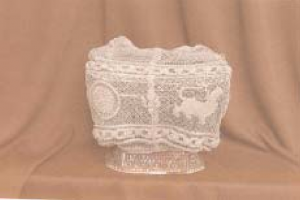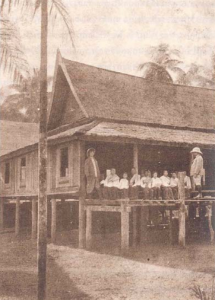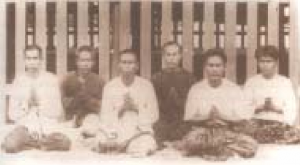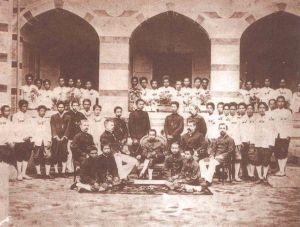In regard to the former working procedure in ministry of interior, if there was an official document or official reports from the provinces arrived at Luk Kun Hall during anyone’s shift, take Mr. Kwaen’s shift as an example, Mr. Kwaen had to receive that letter. If it was a private letter endorsing at the back of envelope addressed to Permanent Secretary, he had to receive and send that letter with seal further to Permanent Secretary. If it was a report to the Ministry of Interior, Mr. Kwaen opened the seal, read and inform the Permanent Secretary for the first consideration. The following morning, the Permanent Secretary and Mr. Kwaen together went to the minister’s house. After Mr. Kwaen read the report, the minister would comment and assign work. If the mission were in the authority of minister, then the Permanent Secretary assigned to the officers to draft a letter. Mr. Kwaen again submit it to the minister to proofread. In case of general order formal with a formal pattern, Mr. Kwaen could finish the proposal without verified the first draft by the minister. After that, the duty officers wrote on the papers before sealed by the secretary at the minister’s residence. Master copy had been kept in the ministry, disorganisedly on the ceiling of Luk Kun Hall. I found a lot of official reports during the reign of King Rama IV when I served as the minister (senabodi).
Which official reports from the provinces had to inform the king, Permanent Secretary would be assigned by the minister to find the main idea of each report carefully. The ancient tradition of informing the king that had used until the reign of King Rama III could be seen from “Luang Udom Sombat Annals”, published in 1915. Normally, the king gave a public audience to government officials in the throne hall twice a day, the morning for judicial mission like to judge a case for people and in the evening for interior mission. All ministers had to attend. The Permanent Secretary read the official reports from the provinces, the king advised the ministers, and made the decision. The Permanent Secretary would remember His Highness’s speech and implement afterwards. The king would have a proofread in case of the very important issues. This was obviously the duty of the Permanent Secretary to read and edit the proposal as commented. Throne hall was where the government officers learned and experienced. Later in the reign of King Rama IV, when there was more business associated with foreign governments. Civil service was therefore divided into 2 different types; disclosed and secret. Disclosed issues were discussed in the throne hall. Secret issues would have to report in form of memorandum. If the king would like to consult with some ministers, they would have to meet in a private place. When I was young, I had frequently seen Somdet Chaophraya Borom Maha Sri Suriwongse (Samuha Kalahom). Such memo was written in a black notebook, like an official report read in the hall, but with a white pencil attached to the notebook’s cover for writing. As a result, there were 2 methods of informing the king; the first way was to read during giving a public audience to government officials in the throne hall and the second one was to inform by written. The royal customs had gradually changed. His Majesty had to cope with more royal duties. There was insufficient time to attend the throne hall twice a day. Written method of informing and ordering had been preferred to use. In the reign of Rama V, His Majesty only went to the throne hall to give a public audience in the afternoon and no consulting with the ministers. The ministers subsequently didn’t have to attend. The activity of reading official reports from the provinces became light issues like news about robbery, weather report, rice farming, etc. with the aim to preserve the traditional customs. The letters written in western papers were broadly used in Ministry of Interior and Defence, Krom Tha, and all other government agencies. However, the Ministry of Interior still wrote in the black notebook different from other ministries, the Department of Secretary-General called it “Bread Box” as the Ministry of Interior wrapped notebook and sent to the king in the same size of bread box in the market. Moreover, the messages in official reports were to ask for permission, “What would His Majesty like to do?” Once His Majesty complained that Ministry of Interior had become a post office, all issues had been made by royal decision but the king didn’t change anything about this probably because His Majesty’s decision was final and planned to have a modern person to be a minister and rehabilitate the whole ministry.
Both insiders and outsiders of the Ministry of Interior had been watching over my performance during my first period as Minister of Interior. Some expected that I would change everything immediately but I extremely worried since I didn’t know much about interior and officials in Bangkok and provinces. I decided to learn more to feel confident before managing anything. I had asked from some experienced officials such as Phraya Maha Ammat (Run Siphen) who was Samuha Mahadthai and Chao Phraya Si Thammathirat (Wek Bunyarataphan). Both of them already retired with pension. Remaining Phraya Ratwaranukul (Uam or Phraya Sri Singhathep at that time) who worked as an assistant accountant and the head of officials in Ministry of Interior, I therefore had been asking him about the Ministry of Interior’s governmental procedures since the beginning. Herein, I would like to express Phraya Ratwaranukul (Uam)’s kindness to me. We had been familiar even before I took the position of being Minister of Interior. I felt that he really intended to help me. Anytime we discussed, if he disagreed with me, he would share his opinion directly. After Phraya Si Thammathirat (Wek Bunyarataphan) was promoted to Chao Phraya Sri Singthep, we worked together and represented me when I followed His Majesty or inspected the provinces. Many years later, although he was very old and already retired, he still supported me every way he could. His kindness will never be forgotten.

Phimai District Office in the reign of King Rama 5 decorating with national flag to welcome inspectors from the capital.
Factually, I couldn’t wait until I knew this ministry very well because of urgent issues I needed to solve immediately. I only served as the Minister of Interior, not Samuha NaYok so the missions of Samuha Nayok must be transferred to other ministries, to be more apparently, sending orders of civil service to Ministry of Royal Household, Court of Appeals for provinces transferred to the newly established Ministry of Justice. The regulations in the Ministry of Interior also had to be resolved. The very first one was to remove the tradition that officials had to work at the minister’s residence. I worked every day at Luk Kun Hall, and arranged meeting. The officials brought the official document to the meeting once a day every day. During the meeting, Phraya Ratwaranukul sat next to me so I could confer with him anytime I had to make the decision. If we thought differently and there were very important issues that shouldn’t be ordered arbitrarily. Then, it would be brought to the king to ask for advice or permission personally as appropriate. I removed the method of writing notes in the black notebook and send the letter instead. I usually drafted those letters to inform and share my opinion. Final decision belonged to His Majesty.

A bed decorated with pearls wrapped in golden mesh, embroidered he image of the Rajasiha and the Discus used for the seal of Ministry of Interior, currently preserved at the Ministry of Interior
My first day of being the Minister of Interior, Chao Phraya Rattana Bordin told the secretary to send the Discus (Chakra) and the Seal of the Rajasiha (Lion) for my position to me at Luk Kun Hall. They looked not that special in a silver box made in Chiang Mai. The secretary said that the ministers had to find a box when they first received the seals. When Prince Mahamala Kromphra Bamrab Porapak was the Minister of Interior, he used the carton or may be niello ware. I hadn’t known that I had to prepare the box so I asked the secretary if I could borrow the box of Chao Phraya Rattana Bordin. The secretary told me that there was a ‘tieb’ (kind of container with a base and a cone-lid) decorated with pearls on the ceiling, guessed that it was used for keeping the seals since the reign of King Rama I. I took a look at it and agreed with the secretary to keep the seals in it and would find another new one. This was also to remove the tradition of taking the seals home.
Apart from what I mentioned earlier, most of things still remained the same such as job description and regulations. I often visited the provinces as an inspector so I felt more familiar with all the officials in the ministry, both juniors and seniors. Six months later, I felt confident enough that I was able to command by myself. I decided to seek more knowledge about the provincial administration. In order to achieve this, I had to travel to each province. His Majesty agreed and allowed me to do so. I went to the north in October by boat. It was no train to the north. I left Bangkok by boat to Uttaradit, and then I walked to Sawankalok before taking a boat to Sukothai and walked to Tak. I took a boat from Tak returned to Ang Thong and walked to Suphanburi. Finally, I returned to Bangkok by boat in December. I was surprised to know that at Nakhonsawan, my journey was the first time that the minister went to inspect. Normally, the former ministers only travelled to other provinces when there was war, etc. However, I realised that the inspection across provinces created great benefits. As a result, I had inspected various provinces for over 20 years throughout my term as the Minister of Interior.

The photo of “Yod Chaiya”, the boat that Prince Damrong Rajanubhab took for his inspection trip
The traditions of provincial administration will be presented. The provincial administration in that age, the ancient law called “Kin Muaeng” (Governing towns) that seemed to be used in all Eastern Asian countries. In China, it was also called Kin Muaeng in Chinese. In Thailand, this term was later called “Administering civil affairs” but the word ‘Kin Muaeng’ still remained in spoken and old books like the royal law. This principle stated that the governor had to leave his business and give civil affairs the first priority, to ensure that people were happy and safe. People had to repay the governor with their exertion or sharing food, etc. The administrative officials who were the assistant governor gained the same benefit but lessened due to the rank. When money became more important in living, the benefit they had received was insufficient. The administrative officials increased their income by trading, and farming. Their job facilitated them a lot. They could ask people to help them with farming for free. The pork-barrel among concessionaires (holder of a government monopoly) from Bangkok and these administrative officials, if they got interest, the work of concessionaires would be done more easily. This was the source of corruption. Those who were afraid of guilt wouldn’t do this but those who greedy to take everything would finally cave in as the governor of Suphanburi that I had mentioned in the 4th story ‘Don’t go to Suphan city’.
Most people I had met during the trip to the north were “aristocrat”. As descendants of previous governors which had carried out civil service work to make a living until settling in that city, having a child to serve as a servant first or train to do civil service in that city until receiving royal letter of appointment as a civil servant, Permanent Secretary, or even the governor and then stayed in that city for the rest of his life. Officials in Bangkok were rarely interested to work in other provinces since they were afraid of the difficulty in living. In case they had to go there, they needed to have some money or to marry with the daughter of some rich people in that city.

Prior to the bureaucratic reform in the reign of King Rama V, there were no government agencies in the provinces. House of the governor was used as an office. In the picture is the parlour of Sakon Nakhon governor
Surprisedly, there were no permanent government pavilions in the provinces for administration like today. The governors administered at home, the same as the ministers in capital did. The house of governor was called “Juan” because it was a hall built in front of the house, outside the fence called ‘Town Hall’ where they held meeting with the administrative officials and judged a case. Central Hall was similar to Luk Kun Hall in the capital city.
In 1866, during a trip to the north, when King Rama IV found that central hall in various provinces were so shabby, His Majesty bestowed on 800 baht for each province to fix or rebuild, also the coin with the image of Phra Maha Mongkut to stick at town hall. I borrowed it to simulate and preserve the design. Now, it is in the National Museum. But later the town hall was declined again. The reason for this was that the governors had to build “Juan” (Name of the provincial governor’s house) if their provinces were located without fortification such as Phitsanulok. Provincial governor had to buy land. Juan and town hall were built with governor’s money. When the governors passed away, these buildings belonged to their children. If the new governor hadn’t been an heir of the former governor, he had to find a place to build Juan and a new town hall, according to his wealth. Government agencies were established permanently when Thesaphiban had already been created. For administrative officials, most of them were rich. They stayed where they normally lived but they had to go to work at Juan (the governor’s residence). The governor wanted them to be peacekeepers as they knew a number of people so thieves were afraid of them, similar to the district chief in Thesaphiban. In contrast, sometimes it led to bad consequences as the case at the beginning of King Rama V, the keeper of Ayutthaya set up a house called “Chang”, served as Luang Banthao on Yai Island where was desolated. He was famous in welcoming noblemen and government officials. No thieves dared to rob or attack. It had been like this from the late reign of King Rama IV. The truth was revealed in the reign of King Rama V when many of bandits confessed that they worked for Luang Banthao. He was the head of bandit’s den ordered those bandits to rob outside his area. Finally, Luang Banthao was executed. Once I visited Northern provinces, there were still a lot of gangers because there hadn’t have policeman yet. I thought I met two officials who earned for living illegally. The first person named “Khun Lok Chub” lived in Payuhakeeree. He was very old when I met him. I had heard that he became a monk and died. The second one was Luang Sri Mongkol lived in Ang Thong. The governor called him “the right hand”. Luang Sri Mongkol provided me a horse and people for carrying things. Also, he volunteered to ride a horse leading me. I was impressed him since then. After setting up Monthon Thesaphiban, it disclosed that Luang Sri Mongkol directed to plunder another province. At first, Krom Khun Maruphong Siribhat, Samuha Thesaphiban didn’t believe since Luang Sri Mongkol was his favourite person as well. After completed the investigation, the court sentenced Luang Sri Mongkhon for many years. Krom Khun Maruphong therefore said that “The method of raising a thief to catch the thief is not usable” but during Thesaphiban period, the District Office was based in the country together with provincial police officers then didn’t have to rely on the administrative officers like before.
There was another department called “Department of China” because they were Chinese or Chinese children with braids. These Chinese people earned living in the provinces. Some of them could establish themselves. According to the law, in the past, to a person holding at least 400 Rai of land was a court case, so he appointed a lawyer to represent him. The taxation often has to be a complaint to the people frequently. If the concessionaire had to go to court frequently, they were unable to collect the tax. In order to solve this problem, when the government appointed whoever as a concessionaire, that person also became a government official, “Khun” with 400 Rai and could be promoted to Luang or Phra. There was a concessionaire in the capital city and the Department of China in the provinces. Some of them were assistant governors and usually donated their money to support variety of affairs. This made them got along well with every class of people.

The “gangster” ( Chinese secret society) that was arrested and sent to the court
To travel by boat had offered me the scenarios of all provinces; also I had more hours to read books and grasped that the mutual purpose of both old and new administration was “in peace” but they interpreted this term differently. The former one considers that “when the country free from danger” such as thieves, etc. “is in peace”. This could be observed in some departments that had changed the ancient laws often claiming about the thieves. Therefore, in the provinces, the administrative officials intended to maintain order as well as the minister in national level would be praised when the nation was in peace. The idea of making the country stay in peace must maintain order regularly not only when it’s agitated. This seemed to be the new model of administration, occurred in the reign of King Rama IV and considered as the key principles of the government’s policy in the reign of King Rama V.

Prince Damrong Rajanubhab, manager of Survey School in 1882 took a photo with the first generation of students and director of Survey Department namely, Mccarthy (Phra Vipakphuwadol) at The Damrong stitya Bridge in 1889
I decided to modify the working system in Ministry of Interior after I returned from the trip, started with arranging documents and letters in the office. In this part, Chao Phraya Sadej, had been promoted from Luang Phaisan Silpasart to Phra Montri Pojanakij. He could support me so well because he knew the method of new official letter of Prince Devawongse Varoprakar. I had applied such method to Ministry of Religious Affairs. Phraya Sadej was so nice and able to inform the new regulations to other officials very clearly. Additionally, Phraya Maha Ammat (Seng Viriyasiri), former student from Nantha Uthayan School, was highly fluent in English. He left the school and worked with me the time His majesty assigned me to set up Survey Department in Bureau of Lord Chamberlain. Therefore, I sent him to be a student and interpreter of Phra Vipakphuwadol (James Mccarthy) and became Luang Thesajit Pijarn. When I moved to be the Minister of Interior, Luang Thesajit Pijarn was surveying at Luang Prabang Province before applying to the Ministry of Interior. I thought there were only me knew foreign language so I accepted him to be Phra Sarit Pojanakorn, worked together with Chao Phraya Sadej. These were two outsiders that got accepted into the ministry. Chao Phraya Sadej hadn’t stayed long. The former queen, Sri Bajarindra asked him to teach King Rama VI during staying in abroad as mentioned in the 14th story, the Royal Pages Colleges. While Luang Thesajit Pijarn was promoted to Phraya Sri Sahathep before becoming Phraya Maha Ammat, Deputy minister until I left the ministry. As for the former government officials who had been in the Ministry of Interior for a long time, I then chose to take a position in the new regulation according to his ability. Some people went to serve in higher positions in the provinces. Others were promoted and worked in the ministry. Few of them had been laid off because of the age. At first, old civil servants were afraid as they thought I was so modern that I would bring modern people together to replace the old ones to be retired.
